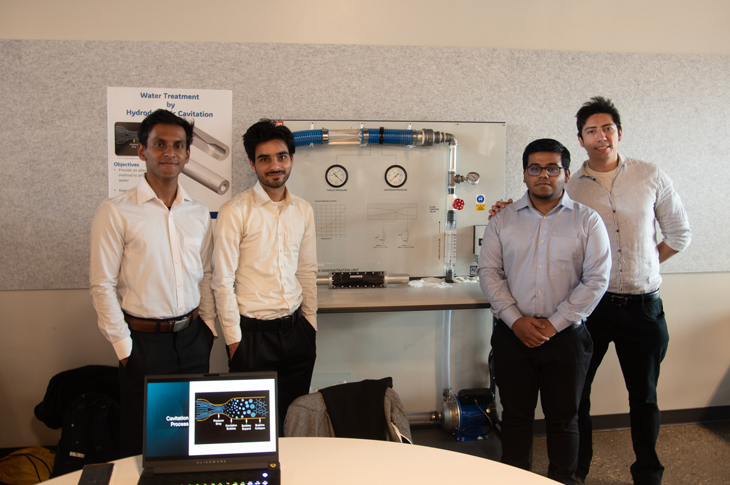Donor support turns ideas into action

Dineesha Vipulatheja, Arjun Singh Brar, Neeladri Roy Barman and Vladimir Rodriguez Arias with their capstone project proto-type.
For SAIT students in a diploma program like Mechanical Engineering Technology, the culmination of their educational journey is a final capstone project. These practical and innovative projects allow students to tackle an open-ended problem and apply their unique creativity and problem-solving abilities to a real-world context.
These innovative solutions often come with a financial cost as they can involve materials or equipment that must be purchased out of pocket. That’s where SAIT’s Innovative Student Project Fund (ISPF) can make a big difference. This donor-supported fund helps students get financial support that allows them to bring their creative classroom-based capstone projects to life.
When Vladimir Rodriguez Arias, Rammandage Vipulatheja, Neeladri Roy Barman and Arjun Singh Brar found out their capstone project proposal had been approved for funding, they were relieved, excited and grateful.
“Getting the funds was a huge step for us,” says Vipulatheja. “We even received congratulations from our instructor, advisor and academic chair from our program because they know how big of a step it is to compete against other teams and secure the funds. It was a great experience!”
All four students came to SAIT from abroad and were attracted to the Mechanical Engineering Technology program’s hands-on and creative design elements.
“I was really interested in engineering and designing something new and real that could work in the real world.” Shares Brar.
Tackling real-world issues
When it came to their capstone project, the four students decided to tackle an increasingly important issue — water treatment. Their project focused on hydrodynamic cavitation (the process of vaporization, bubble generation and bubble implosion, which occurs in a flowing liquid) as a way to treat contaminated water.
“We were able to use some existing equipment,” says Arias. “But to finish the project we envisioned, we needed money for a piping system and water boiler material. So, we had to design a budget to test our ideas.”
That’s when Arias, Vipulatheja, Barman and Brar were encouraged to design a project budget plan and apply for the Innovative Student Project Fund. Working with SAIT instructors and advisors, the students developed, presented and submitted their project plan and hoped for approval.
When their instructors told them that their project had been approved, they all shared an exciting moment together.
“We were all in a group chat and we were celebrating, ‘We got the funds, we got the funds!’”, remembers Vipulatheja. “And now we knew we could do our calculations, build a prototype and get demonstrations.”
With the successful completion of their project, the group gained crucial real-world experience, designing a budget for an innovative project and then presenting the idea to a panel of experts.
When he reflects on the benefits of the project and the impact of a donor-supported fund like the ISPF, Arais says, “It’s a great opportunity and I would encourage any students that have an idea to make this happen because you get a lot of support from your instructors and advisors … This can impact not only your program but also your career because you can have something to show future employers that you have the ability to work on really impactful projects.”
The Innovative Student Project Fund allowed these SAIT students to dive into a global issue from the comfort of their classroom, and work in the interdisciplinary settings that will define the working world they’re about to enter.
Find out how SAIT students are bringing innovative solutions to real-world problems.
Learn how you can make a difference by supporting student success at SAIT.
TOMORROW’S TALENT, TODAY
The Real Futures campaign will enable SAIT to deliver on the promise to transform who, how and what we teach in response to the changes unfolding across our communities, technologies and economies. With a fundraising target of $150 million, the campaign will assure SAIT’s continued ability to provide the training and skills that industry needs to stay relevant and that students need to thrive, whatever vision of tomorrow they’re working toward.
Real Futures
Oki, Âba wathtech, Danit'ada, Tawnshi, Hello.
SAIT is located on the traditional territories of the Niitsitapi (Blackfoot) and the people of Treaty 7 which includes the Siksika, the Piikani, the Kainai, the Tsuut’ina and the Îyârhe Nakoda of Bearspaw, Chiniki and Goodstoney.
We are situated in an area the Blackfoot tribes traditionally called Moh’kinsstis, where the Bow River meets the Elbow River. We now call it the city of Calgary, which is also home to the Métis Nation of Alberta.